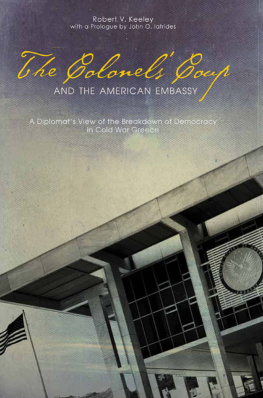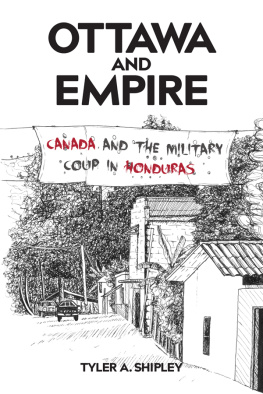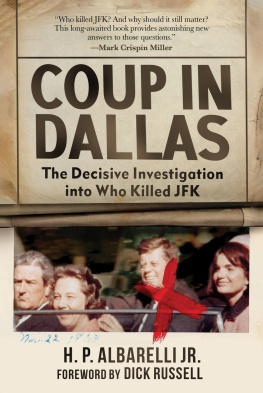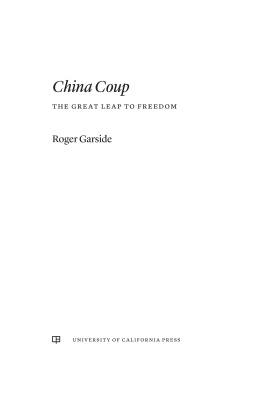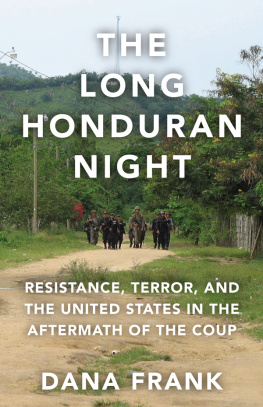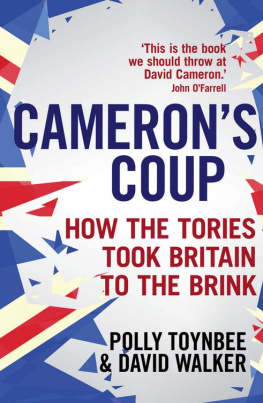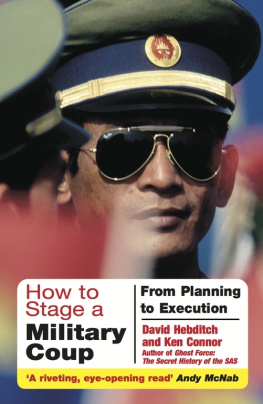COUP DTAT
A PRACTICAL HANDBOOK
REVISED EDITION
EDWARD N. LUTTWAK

Cambridge, Massachusetts
London, England
2016
First published in Great Britain by Allen Lane
The Penguin Press 1968
Preface and Revisions copyright 2016 Edward N. Luttwak
Appendix C. Figures copyright 2016 Luther Patenge
Copyright 1968, 1979 Edward N. Luttwak
All rights reserved
Jacket design: Tim Jones
978-0-674-73726-6 (pbk. : alk. paper)
978-0-674-96965-0 (EPUB)
978-0-674-96966-7 (MOBI)
The Library of Congress has cataloged the printed edition as follows:
Luttwak, Edward, author.
Coup dtat : a practical handbook / Edward N. Luttwak.Revised edition.
pages cm
First published in Great Britain by Allen Lane The Penguin Press 1968Title page verso.
Includes bibliographical references and index.
1. Coups dtatHandbooks, manuals, etc. I. Title.
JC494.L88 2016
321.09dc23 2015033858
To my father, Josif Luttwak z.l., 22 October 1968
And to my mother, Clara z.l., 6 July 1981
Contents
I enlisted Sawyer Blazek, a scholarly practitioner with then recent African experience and now an adviser on national security affairs, to help me update the book. It was a fortunate decision because it was with talented acuity that he separated the old but instructive from the outdated that needed replacement.
Thanks to his work, my revision was greatly facilitated. I am happy to acknowledge his valiant assistance.
When writing what became the first edition of this book almost half a century ago, I scarcely imagined that it would have an entire existence of its own, remaining in print till today through seven editions in English and nineteen editions in foreign languages from Arabic to Russian, although the Chinese edition has been published, very elegantly, only in Taiwan.
A few things have changed since I wrote the original text. Coup plotters, for example, cannot expect to gain much these days by seizing the radio station, first, because instead of a single national radio broadcaster there might now be a dozen, even in very small countries; but more, because broadcasting of any kind counts for less and less in a world of narrowcasting via social media.
This and other technical changes are duly accounted for in this revised text, but all through the years to the last coup recorded in 2015, the essence of the coup dtat has remained exactly the same: it is a special form of politics that requires guns as an aid to persuasion, although coups rarely succeed if guns are much used and fail totally if the situation degenerates into civil warthe polar opposite of the swift and bloodless coup dtat.
In reviewing the text to determine what changes might be needed for the 2016 edition, I found many small details in need of updating but also a major omission: corruption as the trigger of many a coup dtat.
It is all a matter of incentives. In the absence of significant corruption, the coup plotters who risk their necks to overthrow their seniors and seize control of the government can gain only an increase in status, but not vast wealth. The difference in salaries and pensions between colonels and presidents is downright negligible as compared to the risks.
With corruption, however, those who seize power can enrich themselves enormously, sometimes by simply taking what they want from the countrys national bank with its foreign-exchange reserves, or, more discreetly, by taking their cut on all state purchases, by exacting bribes from all who need anything from the government, by securing loans from state banks that are never repaid, or by setting up family members as business agentsindeed there are myriad ways of converting state power into self-enrichment. The corrupt rulers of even the smallest and poorest countries can swiftly become billionaires. Corruption, therefore, actually generates coups because if successful their material rewards can be so very large.
One major change since the original text was published in 1968 has been the widespread implementation of specific anti-coup precautions and provisions. To some degree, they may have been stimulated by the original book itselfor so I have been told by the security officials of more than one country: while coup plotters have tried to benefit from its contents (more on this notion later), potentates and their minders have seemingly done the same in designing their anti-coup measures.
By far the most important is to maintain distinct, indeed entirely separate military, paramilitary, and other security organizations so that none has a monopoly of force. Typically, there is a national, presidential, or revolutionary guard equipped heavily enough to resist the regular army, and also a militia of fellow ethnics in some cases. In addition, there is always some inner-core palace security force of several hundred at least, but sometimes of thousands, exceptionally well trained or at least very well equipped by local standards, and which must of course be commanded by a son or nephew of the ruler, with as many relatives, or at least fellow clan members, as possible in their cadre of officers, and even the other ranks enlisted from the clan or at least the ethnic group of the rulers. Sometimes openly labeled as a Presidential or Royal or Revolutionary guard division, brigade, or regiment, such inner-core forces may also bear deliberately nondescript designations, even though everybody knows that, say, the 12th Division or 27th Brigade or 355th Battalion is really the it forcethe one with all the latest equipment, above-average facilities, higher pay, and the rulers relatives in command.
Even safely democratic countries keep a variety of distinct military and security forces wearing different uniforms despite their overlapping functions. The difference, however, is that their distinct forces are constantly enjoined to communicate, coordinate, and cooperate with each other, and usually come under joint commands staffed by all of them to better unify their actions.
When diversity has an anti-coup function, however, there is no joint operational headquarters, and far from being enjoined to cooperate, any communication among the different forces is discouraged, or even prohibited: social gatherings seemingly as innocent as a birthday party may well evoke acute suspicion, followed perhaps by interrogations if officers of, say, army, national guard, and gendarmerie are all present. This politically imposed absence of intercommunication and coordination is a major cause, incidentally, for the Arab military debacles that foreign observers routinely attribute to gross professional incompetence alone. The case of South Korea is also illustrative: It was precisely for the sake of better coordination in responding to the threat of North Korean commando attacks that the United States pressed the South Koreans to merge their Army Security Command, Navy Security Unit, and Air Force Office of Special Investigations into a single organization. A fully integrated, authentically joint Defense Security Command was ceremoniously inaugurated in October 1977. Two years later, its two-star commanding general, Chun Doo Hwan, used his fully unified command and monopoly of immediate force to seize power when the countrys president, Park Chung Hee, was assassinated. There was no one to restrain him when Chun investigated, judged, and condemned the countrys top general, the armys chief of staff, and then jumped over all the three-star and four-star officers above him to make himself the countrys president. It could not have happened if there had still been three competing security organizations instead of a monopoly.
Next page



